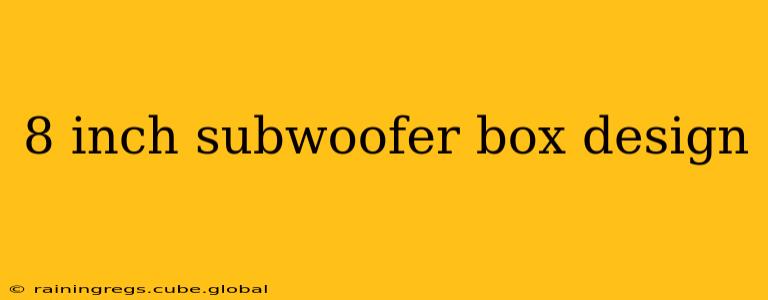Choosing the right enclosure for your 8-inch subwoofer is crucial for optimal sound quality. A poorly designed box can severely limit your subwoofer's performance, resulting in muddy bass, lack of extension, and even damage to the speaker itself. This guide will delve into the key factors to consider when designing an 8-inch subwoofer box, helping you achieve the best possible audio experience.
What Type of Enclosure is Best for an 8-Inch Subwoofer?
This is a frequently asked question, and the answer depends on your priorities. Several enclosure types cater to different preferences:
-
Sealed (Acoustic Suspension): Sealed boxes are known for their tight, accurate bass response. They're generally smaller and simpler to build than ported boxes, making them a popular choice for beginners. However, they generally produce less overall output than ported designs at lower frequencies.
-
Ported (Bass Reflex): Ported enclosures utilize a port (tube) to reinforce the subwoofer's output at a specific frequency, resulting in louder and deeper bass. They require more careful design and tuning but offer greater low-frequency extension. The port's size and placement are critical for achieving optimal performance.
-
Bandpass: Bandpass boxes are more complex, offering a narrow frequency response band with extremely high output within that band. These are generally not recommended for beginners due to their complexity and the potential for high excursion that can damage the subwoofer.
-
Horn: Horn enclosures are highly efficient and can deliver impressive output, but they are very large and complex to build, requiring precise calculations and specialized materials. They are rarely used for 8-inch subwoofers.
What Are the Key Design Considerations for an 8-Inch Subwoofer Box?
Several critical factors influence the final design of your subwoofer enclosure:
-
Subwoofer Specifications: Consult your subwoofer's specifications sheet. This document will provide crucial information, such as the subwoofer's recommended enclosure volume, tuning frequency (for ported designs), and maximum power handling. Ignoring these recommendations can lead to suboptimal performance or even damage to your speaker.
-
Enclosure Volume: The internal volume of the enclosure significantly impacts the low-frequency response. A smaller enclosure will generally result in a tighter, faster bass response, while a larger enclosure will produce more output but potentially with less precision. Again, consult your subwoofer's specifications for the recommended volume range.
-
Tuning Frequency (for Ported Enclosures): The tuning frequency determines the frequency at which the port resonates, enhancing the output at that specific point. Accurate tuning is critical for a ported enclosure to perform optimally. Software and online calculators can assist in determining the appropriate tuning frequency.
-
Port Design: The port's length, diameter, and shape influence the tuning frequency and airflow. Several port designs exist, each with its own characteristics. Common choices include flared ports (for reduced turbulence) and straight ports (simpler to construct).
-
Internal Bracing: Internal bracing helps to strengthen the enclosure, reducing unwanted vibrations and improving the overall sound quality. This is especially important for larger enclosures.
-
Material Selection: MDF (Medium-Density Fiberboard) is a popular choice for subwoofer enclosures due to its stiffness, density, and damping properties. Other materials such as plywood can also be used, but MDF is generally preferred.
How Do I Calculate the Right Enclosure Size for My 8-Inch Subwoofer?
There are numerous online calculators and software programs specifically designed to assist with subwoofer enclosure design. These tools often require inputting your subwoofer's parameters (Thiele/Small parameters) to calculate the optimal enclosure volume and port dimensions (if using a ported design). Many free resources are available online.
What Are Some Common Mistakes to Avoid When Building an 8-Inch Subwoofer Box?
-
Ignoring Subwoofer Specifications: This is the most common mistake. Always consult your subwoofer's specifications before starting any design.
-
Poorly Sealed Enclosure: Leaks in the enclosure will drastically reduce efficiency and impact the overall sound quality. Ensure all joints are properly sealed with appropriate adhesive and sealant.
-
Incorrect Port Design (for Ported Enclosures): A poorly designed port can lead to unwanted resonance and distortion. Use a reliable calculator and follow the instructions carefully.
-
Insufficient Bracing: A flimsy enclosure will vibrate excessively, negatively affecting sound quality. Proper bracing is essential, especially for larger boxes.
Where Can I Find More Information on Subwoofer Box Design?
Numerous online resources, including forums and websites dedicated to car audio and home audio, offer valuable information and design tools. Searching for "subwoofer box design calculator" or "Thiele/Small parameters" will lead you to numerous helpful resources. Remember that designing a subwoofer enclosure requires precision and attention to detail. Taking the time to learn the basics and utilize the available tools will significantly improve your chances of building a high-quality enclosure for your 8-inch subwoofer.
